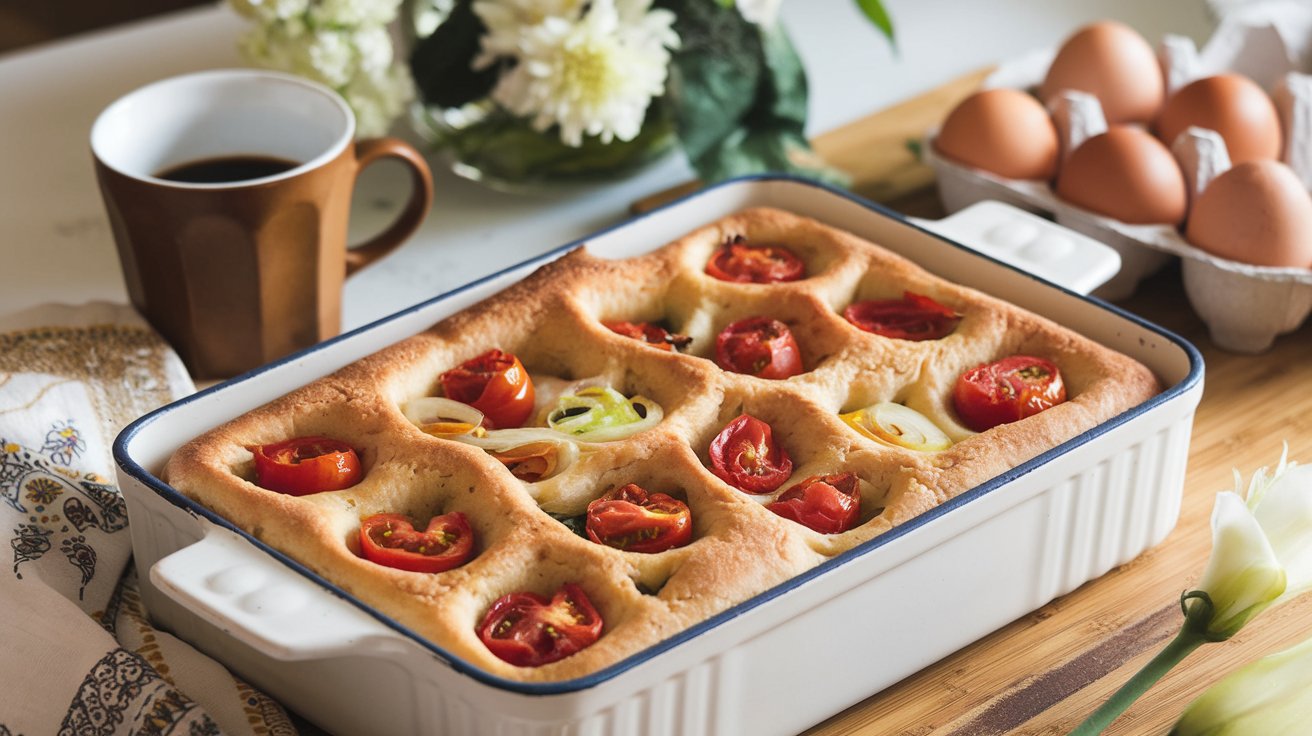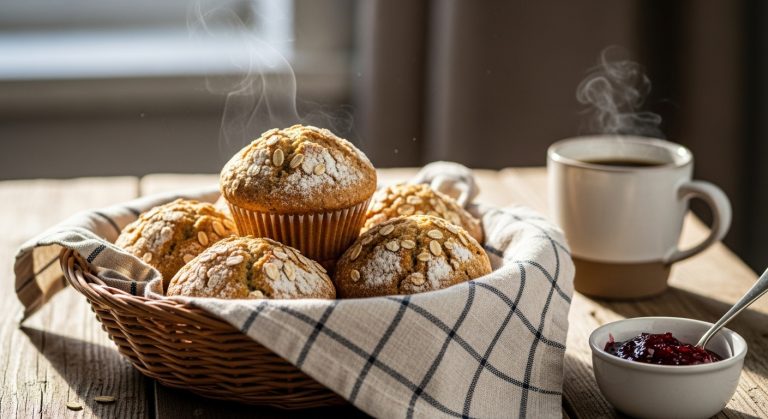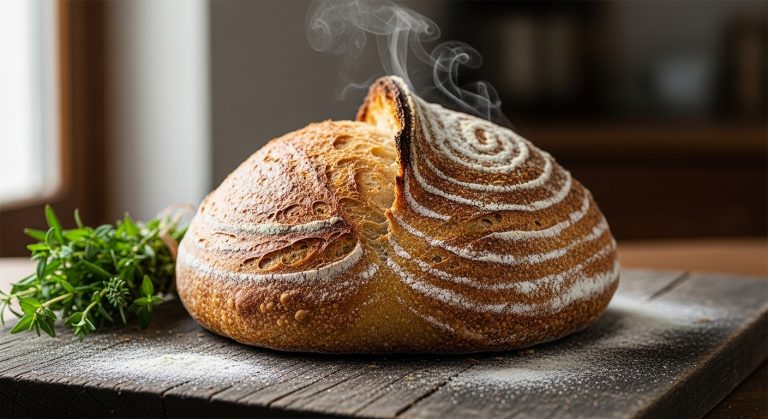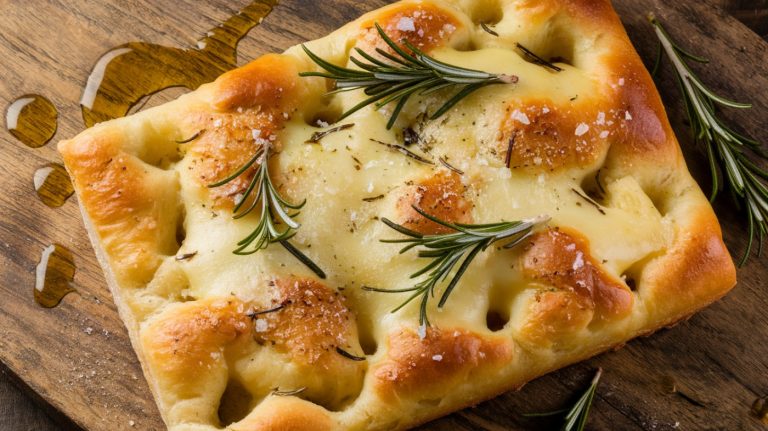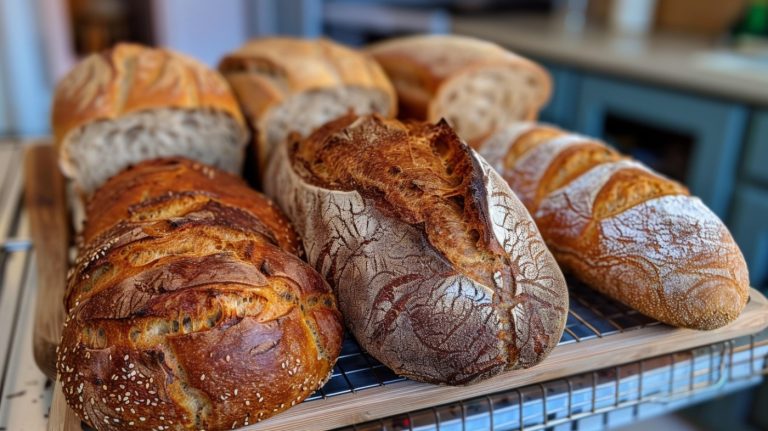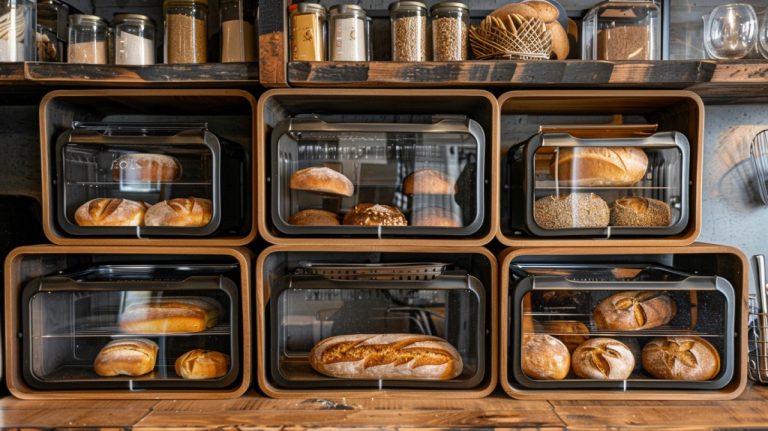Gluten Free Sourdough Focaccia: Bite Into a Puffy, Bubbly Crust
You can whip up a delicious gluten-free sourdough focaccia that’s loaded with flavor and nutrition. Start with a gluten-free flour blend, almond flour, and psyllium husk to create a tender, airy texture.
An active sourdough starter brings in probiotics and a unique tang that elevates your focaccia. With a high hydration level, you’ll end up with a soft crumb and a delightful crust.
Don’t forget to add your favorite toppings like rosemary or olives for extra flair! Each step of the process reveals more tasty possibilities for perfecting your focaccia. There’s so much more to explore.
Key Takeaways
- Use a gluten-free flour blend like brown rice, sorghum, and quinoa for structure and flavor in your focaccia.
- Incorporate psyllium husk to improve texture and elasticity, mimicking traditional gluten properties.
- Feed your active sourdough starter 1-2 times before use to ensure optimal fermentation and flavor.
- Allow the dough to rise in a warm environment for 3-5 hours until light and puffy for best results.
- Experiment with toppings like fresh herbs, olives, or vegan cheese to enhance flavor and variety in your focaccia.
Ingredients and Their Benefits
When crafting gluten-free sourdough focaccia, the right ingredients make all the difference in taste and texture. Start with a well-balanced gluten-free flour blend, combining brown rice, sorghum, and quinoa. This mix provides essential structure and flavor, making your focaccia suitable for those with celiac disease or gluten sensitivity.
Incorporating almond flour into your blend can also enhance the flavor profile, adding nuttiness and moisture, while its unique properties contribute to a tender crumb.
Next, add psyllium husk. This powerhouse ingredient acts as a binder, enhancing elasticity and improving the texture of your gluten-free sourdough focaccia by mimicking gluten’s properties.
Don’t forget an active sourdough starter; it’s vital for fermentation. An active starter introduces beneficial probiotics, enriching the flavor and promoting easy digestion.
Olive oil is another important ingredient that contributes moisture and flavor. Its healthy fats not only elevate your focaccia but also provide anti-inflammatory benefits.
Finally, embrace a high hydration level in your dough. By increasing the water content, you’ll achieve a softer crumb and a delightful crust, creating a more authentic bread-like experience.
Starter Preparation
To create a robust gluten-free sourdough starter, you’ll need to focus on feeding it regularly and mastering some activation techniques.
A well-maintained starter should be bubbly and have a tangy aroma, which are signs of a thriving fermentation process. Keeping your starter bubbly and lively requires a bit of attention, but don’t worry—troubleshooting common issues can help you get back on track quickly.
For instance, ensuring that you use the right starter feeding schedule can make a significant difference in its activity levels.
Feeding Your Starter
A thriving gluten-free sourdough starter is the heart of your baking success, and caring for it properly is crucial. To keep your starter active and bubbly, you’ll want to feed it 1-2 times within 24 hours before using it. This guarantees ideal fermentation results for your gluten-free focaccia.
Start by mixing equal parts gluten-free flour and water in a 1:1 ratio to create a thick paste. Let it rise until doubled in size; then, it’s ready for your recipes.
To enhance flavor, consider making a levain by combining 50g of your active starter with 100g of gluten-free flour and 100g of warm water. Allow this mixture to ferment until it’s bubbly and has also doubled in volume.
Remember to discard a portion of your starter while feeding it regularly; this prevents acidity from building up and keeps the balance of yeast and bacteria just right.
For the best results, keep your starter in a warm environment, around 75°F to 80°F. Adjust your feeding frequency based on how your starter bubbles and rises, guaranteeing it’s always primed for your next baking adventure!
Starter Activation
Starter activation techniques significantly guarantee that your gluten-free sourdough starter is primed for baking. To get your starter ready, it’s vital to feed it 1-2 times within the 24 hours leading up to its use. This will help it become bubbly and double in size, which is a clear sign of an active starter.
Regularly monitoring your starter’s consistency and aroma is key to maintaining its health and vigor, as a well-cared-for starter develops complex flavors that enhance your baked goods, contributing to the benefits of sourdough starter.
For direct use, mix 125g of gluten-free flour with 125g of warm water to create a total of 250g of starter. Alternatively, you can prepare a levain by combining 50g of your active starter, 100g of gluten-free flour, and 100g of warm water.
Maintaining a warm environment, around 75°F, will promote fermentation and encourage the bubbling action necessary for a lively starter.
Remember to discard a portion of your starter regularly and replenish it with equal parts flour and warm water. This practice keeps your gluten-free sourdough starter healthy and guarantees consistent baking performance.
Step-by-Step Recipe
Now that you’ve prepared your gluten-free sourdough starter, it’s time to gather the essential ingredients for a delicious focaccia.
You’ll mix psyllium husk with warm water, combine it with your active starter and gluten-free flour, and follow key baking techniques to achieve that perfect crust.
Baking Tips
When it comes to gluten-free sourdough focaccia, mastering baking techniques can make all the difference in achieving that perfect texture and flavor. Start by utilizing cold fermentation; allowing your dough to rise in a cooler environment enhances flavor development and promotes a beautiful oven spring.
For the best results, make certain the dough rises in a warm environment of about 75-80°F to encourage yeast activity, which results in light and airy bread.
When mixing your dough, consider using a combination of potato and tapioca starch. This mix lightens the texture, guaranteeing your focaccia isn’t dense.
Once your dough is ready, bake it on a sheet pan. This enhances airflow around the bread, leading to a more even rise and a crust that’s just right.
Keep a close eye on your oven temperature. Start baking your focaccia at 425°F, then reduce it to 400°F to guarantee it cooks evenly.
This temperature management is essential for developing that desirable golden brown crust.
Troubleshooting Common Issues
Troubleshooting common issues with gluten-free sourdough focaccia can save your baking efforts from falling flat. If your focaccia doesn’t turn out as expected, take a moment to assess the following common problems:
- Dry focaccia: This often stems from ingredient substitutions or incorrect rising times. Make certain your dough is adequately hydrated and allowed to rise until it’s puffy.
- Sticky texture: A sticky focaccia usually indicates under-proofing or underbaking. Keep an eye on the dough as it’s rising; it should reach a light and airy consistency before you pop it in the baking pan.
- Gummy interiors: This can result from excessive dimpling or incorrect flour ratios. Be mindful of how much gluten-free flour you use and the depth of the dimples in the dough.
- Dense and soggy bread: Insufficient rising time or using only brown rice flour without added starch can cause this. Consider incorporating starches for better texture and rise.
If your focaccia lacks rise, verify your sourdough starter is active and bubbly, and keep the dough in a warm environment during proofing for the best results.
Popular Toppings and Variations
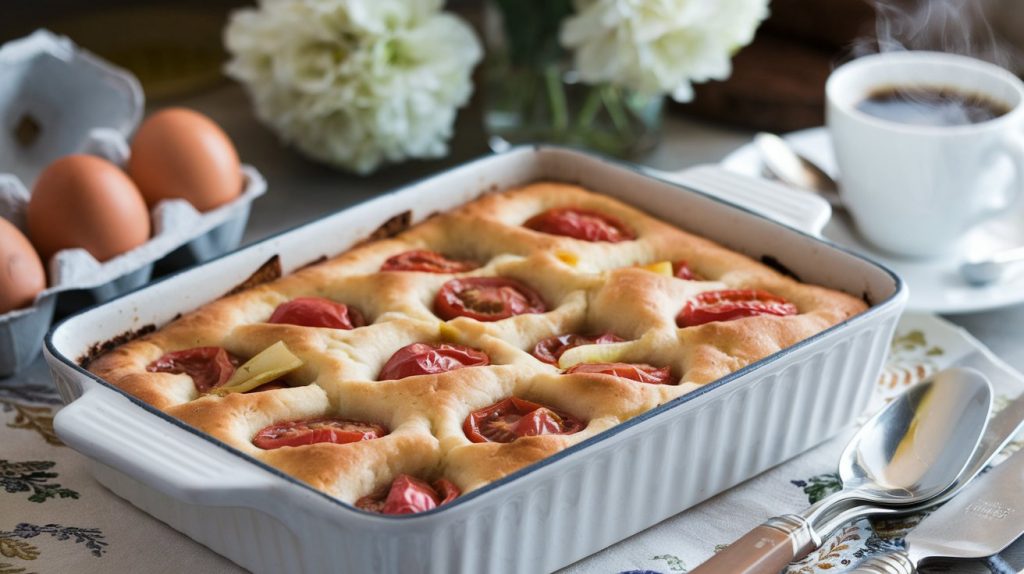
After perfecting your gluten-free sourdough focaccia, it’s time to elevate it with delightful toppings and variations that bring your bread to life. Start by layering on fresh herbs like rosemary and thyme, which not only enhance the flavor profile but also fill your kitchen with an enticing aroma.
You can also explore topping options such as slow-roasted tomatoes or caramelized onions; their rich flavors beautifully complement the savory elements of the focaccia.
For a savory twist, olives or sun-dried tomatoes can introduce a briny contrast, adding depth to each bite. If you’re a cheese lover, crumbling vegan cheese or feta on top provides a creamy, flavorful finish. Alternatively, a sprinkle of nutritional yeast can mimic cheesy notes in vegan options.
Don’t stop there—experiment with seasoning blends like everything bagel seasoning or zaatar to take your focaccia to new heights.
Each combination not only enhances the taste but also makes your focaccia more unique and appealing. So, mix and match these toppings and variations to create a focaccia that’s truly your own!
Serving Suggestions and Pairings
Serving your gluten-free sourdough focaccia can transform a simple meal into a delightful experience. This versatile bread enhances various dishes, making it a perfect addition to your dining table.
You can enjoy it in numerous ways that elevate flavors and textures, whether you’re hosting a gathering or enjoying a cozy dinner at home.
Here are some delightful serving suggestions:
- Dips: Pair your focaccia with balsamic vinegar, hummus, or olive tapenade for a burst of flavor.
- Soups and Salads: Use it as a side to soups and salads, where its texture contrasts beautifully with the warmth of the soup or the crunch of fresh greens.
- Bruschetta: Transform focaccia into a base for bruschetta, topped with fresh tomatoes, cheese, or roasted vegetables for a satisfying appetizer.
- Pasta Dishes: Serve it alongside pasta for a heartier meal, letting the focaccia soak up delicious sauces and flavors.
Storage and Reheating Tips
To guarantee your gluten-free sourdough focaccia stays delicious and fresh, proper storage and reheating techniques are essential. Start by letting your focaccia cool completely. For short-term storage, place it in a paper bag and then put that bag into a plastic one. This keeps the focaccia fresh for up to two days. If you want to extend its life, wrap it tightly in plastic wrap or aluminum foil and freeze it. This method preserves its flavor and texture for up to three months.
When it’s time to enjoy your focaccia again, you’ll want to reheat it for the best experience. Here’s a quick guide:
| Method | Time |
|---|---|
| Oven | 10-15 minutes at 350°F (175°C) |
| Toaster/Toaster Oven | Toast until crispy |
Reheating in the oven restores both crispiness and warmth while toasting slices is a convenient option for a quick treat. If stored correctly, your focaccia can maintain its fluffiness, making it perfect for sandwiches or as a side dish with dips.
Frequently Asked Questions
Is Sourdough Bread OK if You Are Gluten Free?
Sourdough bread isn’t okay for you if you’re gluten-free, as traditional recipes contain gluten. However, gluten-free sourdough made with alternative flours can offer a delicious, safe option while maintaining some of that beloved sourdough flavor.
Why Is My Gluten Free Focaccia Not Rising?
In this modern age, if your focaccia isn’t rising, check if your sourdough starter’s active, guarantee proper flour mix includes starches, and make sure it’s warm enough for adequate proofing and hydration.
Can You Use Gluten Free Flour for Sourdough Starter?
Yes, you can definitely use gluten-free flour for a sourdough starter! Combine equal parts gluten-free flour and water, feed it regularly, and watch for bubbles. Your starter will develop unique flavors and textures as it thrives.
Is Gluten Free Sourdough Bread OK for Ibs?
While some worry gluten-free sourdough might still upset their stomach, it’s often lower in FODMAPs and easier to digest. Just listen to your body and consult a professional to guarantee it suits your IBS needs.
The Joy of Sourdough Focaccia: Endless Possibilities
You’ve transformed simple ingredients into a golden, crusty focaccia that’s not just gluten-free but bursting with flavor. Picture the contrast: a warm, airy interior cradled by a crisp exterior, inviting you to take a bite.
Each slice pairs beautifully with your favorite dips or toppings, making it perfect for gatherings or quiet evenings at home. So, whether you’re savoring it fresh from the oven or reheating it later, this focaccia is sure to delight your taste buds every time.

